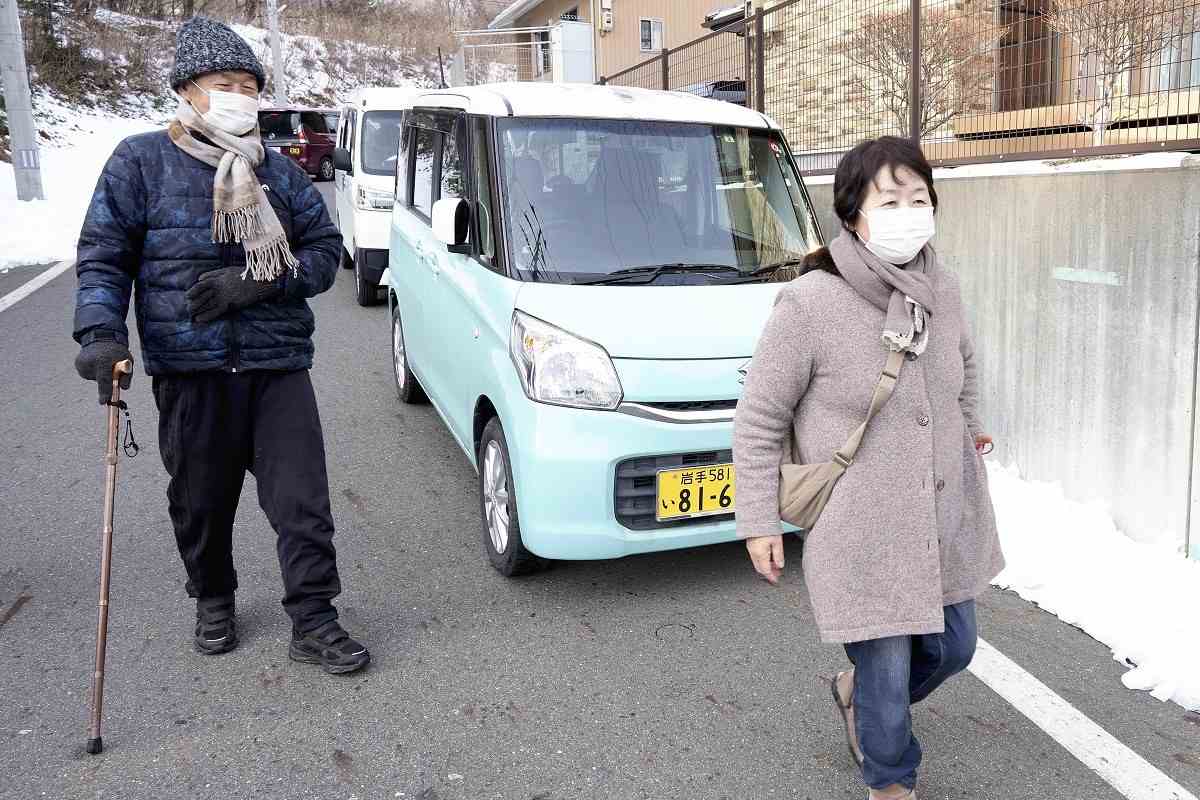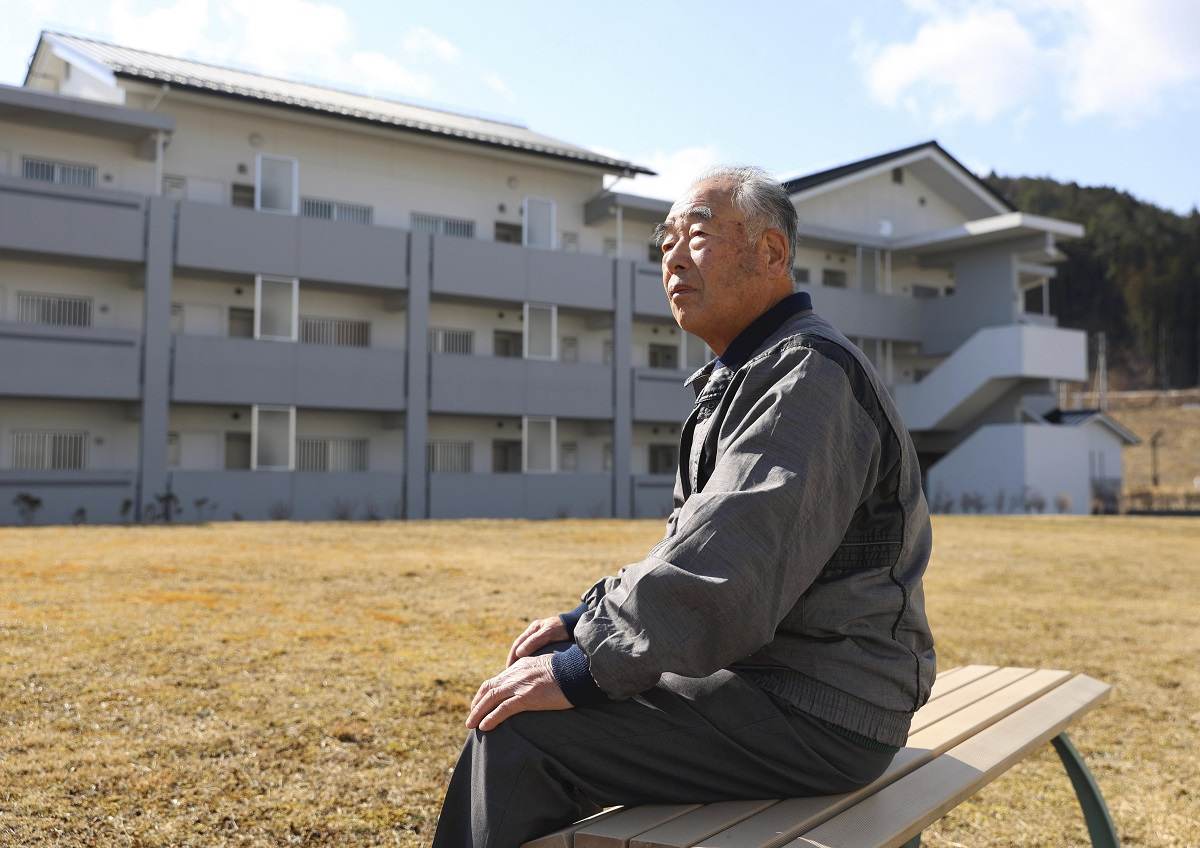13 Years Since the Great East Japan Earthquake / Car Use Reconsidered in Tsunami Evacuation Plans; Traffic Jams Are Deadly, But Some Cannot Flee on Foot

Ine Suzuki, right, and her husband use a car during an evacuation drill in Kamaishi, Iwate Prefecture, on Sunday.
The Yomiuri Shimbun
7:00 JST, March 7, 2024
This is the second installment of a series that explores the current reality in areas affected by the 2011 Great East Japan Earthquake
***
The city government of Kamaishi, Iwate Prefecture, held an evacuation drill on Sunday on the premise that a major tsunami warning had been issued.
Although the city’s policy calls for evacuation on foot, about 30 elderly people who live by the sea were evacuated by car that day and driven to higher ground in 14 vehicles.
Ine Suzuki, 70, took her 76-year-old husband, who has a disability in his left leg, in a car and arrived at the evacuation site on high ground about 600 meters away in about five minutes.
“If we walk, we may be too late to escape,” she said. “Considering what will happen after the evacuation, we’ll need a car.”
With the rapid aging of the population in the areas affected by the Great East Japan Earthquake, an increasing number of vulnerable people are finding it difficult to evacuate.
Walking has been the general rule for escape from an impending tsunami. Now, evacuation by car is becoming a realistic option, although many people who used cars to try to evacuate in the 2011 disaster were killed by tsunami.
When The Yomiuri Shimbun asked the governments of 37 coastal municipalities in Iwate, Miyagi and Fukushima prefectures in January and February about the pros and cons of evacuating by car, seven municipalities, including Yamamoto, Miyagi Prefecture, said they were “fully in favor” or were considering such an option.
Meanwhile, 23 municipalities responded that they were “conditionally accepting” or were considering such an option for the elderly and disabled only, and 17 municipalities had included it as one of the evacuation options in their local disaster preparedness plans.
One of the reasons why evacuation by car is now an option is due to a map of areas at risk of inundation by tsunami released by the government’s Central Disaster Management Council in 2021. It presumed the largest-level tsunami damage caused by a massive earthquake with an epicenter in or around the Japan Trench and Chishima Trench off the coast of the Tohoku region.
In the worst-case scenario, tsunami waves of up to 29.7 meters would reach Miyako, Iwate Prefecture, killing about 20,000 people in the three prefectures, surpassing the death toll from the Great East Japan Earthquake.
The central government’s basic plan urges local governments to “consider evacuation by car in accordance with local conditions,” such as when evacuation by foot is difficult.
According to a survey by the National Police Agency, 91% of the 15,786 bodies autopsied in the disaster were found to have died of drowning.
By age, 56% of the victims were 65 years old or older, indicating that many elderly people died because they were unable to evacuate from the tsunami.
It is estimated that people aged 75 or older will account for more than 20% of the population of the three prefectures by 2030. Therefore, there is an urgent need to establish a method to evacuate them to a safe place in a short period of time.
Traffic congestion is an issue. According to a survey conducted by the Cabinet Office in 2012, nearly 60% of respondents from the coastal areas in the three prefectures had evacuated by car immediately after the earthquake. More than 30% of the respondents cited traffic congestion as a problem.
In Miyagi Prefecture, 575 bodies were found in cars in the disaster.
“The fact that there were victims caught in tsunami 13 years ago while stuck in a traffic jam is a serious matter,” a disaster management official of the Kamaishi municipal government said.
The Noto Peninsula Earthquake in January caused traffic jams in the northernmost region of the peninsula where a major tsunami warning was issued.
Company employee Seiichi Kitagawa, 56, who was at a supermarket in Suzu, Ishikawa Prefecture, when the quake hit, encountered a traffic jam of several dozen cars while evacuating to higher ground, and abandoned his car on a footpath between rice paddies. It was about 10 minutes later that the tsunami hit the supermarket.
“I had no choice but to use my car, but it was a risky choice,” he said.
Meanwhile, efforts are underway to prevent traffic congestion.
Higashi-Matsushima, Miyagi Prefecture, plans to widen a road, and establish a 200-car parking lot as an evacuation site at a roadside rest area scheduled to open in an area away from the coast.
In the Hanagama district of Yamamoto in the prefecture, residents are divided into groups of five or six households. In the event of an earthquake, they are to call each other and form carpools.
Makoto Okumura, professor at the International Research Institute of Disaster Science at Tohoku University, said that it is necessary to increase the options for means of evacuation.
“While considering whether or not to evacuate by car depending on local conditions, it is necessary to promote the designation of evacuation buildings and the construction of towers that allow vertical evacuation in densely populated areas,” he said.
Related Article
Popular Articles
Popular articles in the past 24 hours
-

Suntory CEO Says Beer to Be Company's ‘Top Priority;’ Tax Cut on ...
-

Poll Finds High Approval Rating for PM Takaichi’s Economic Measur...
-

Diplomacy with Central Asia: Utilize Long-Established Relationshi...
-

Japan Actor Ryoko Hirosue Given Summary Indictment over Car Accid...
-

Japanese Actors Haru, Mahiro Takasugi Announce Marriage
-

Japan Shares Rise as Bond Yields Retreat; Tech Jitters Weigh on N...
-

9 Japanese Police Officers Suspected of Online Casino Gambling
-

Hepburn Romaji Deemed Standard for Japanese Words, Names; Change ...
Popular articles in the past week
-

Israeli Tourists Refused Accommodation at Hotel in Japan’s Nagano...
-

U.S. Senate Resolution Backs Japan, Condemns China's Pressure
-

Sharp Decline in Number of Chinese Tourists But Overall Number of...
-

Japan Set to Participate in EU's R&D Framework, Aims to Boost Coo...
-

China Attacks Japan at U.N. Security Council Meetings; Representa...
-

Japan Backs Public-Private Cooperation on Economic Security; Nati...
-

As Chinese Tourists Shun Japan, Hotels and Stores Suffer
-

Bus Bound for Hokkaido's New Chitose Airport Catches Fire Wednesd...
Popular articles in the past month
-

Tokyo Economic Security Forum to Hold Inaugural Meeting Amid Tens...
-

Keidanren Chairman Yoshinobu Tsutsui Visits Kashiwazaki-Kariwa Nu...
-

Imports of Rare Earths from China Facing Delays, May Be Caused by...
-

University of Tokyo Professor Discusses Japanese Economic Securit...
-

Japan Pulls out of Vietnam Nuclear Project, Complicating Hanoi's ...
-

Govt Aims to Expand NISA Program Lineup, Abolish Age Restriction
-

Blanket Eel Trade Restrictions Rejected
-

Key Japan Labor Group to Seek Pay Scale Hike
"Society" POPULAR ARTICLE
-

M4.9 Earthquake Hits Tokyo, Neighboring Prefectures
-

Israeli Tourists Refused Accommodation at Hotel in Japan’s Nagano Pref., Prompting Protest by Israeli Embassy and Probe by Prefecture
-

M7.5 Earthquake Hits Northern Japan; Tsunami Waves Observed in Hokkaido, Aomori and Iwate Prefectures
-

Tsukiji Market Urges Tourists to Avoid Visiting in Year-End
-

High School in Kyoto Says Students Shoplifted during Recent School Trip to Bali, Indonesia
JN ACCESS RANKING
-

Tokyo Economic Security Forum to Hold Inaugural Meeting Amid Tense Global Environment
-

Keidanren Chairman Yoshinobu Tsutsui Visits Kashiwazaki-Kariwa Nuclear Power Plant; Inspects New Emergency Safety System
-

Imports of Rare Earths from China Facing Delays, May Be Caused by Deterioration of Japan-China Relations
-

University of Tokyo Professor Discusses Japanese Economic Security in Interview Ahead of Forum
-

Japan Pulls out of Vietnam Nuclear Project, Complicating Hanoi’s Power Plans










